The Java Fern, or the under their scientific name microsorum pteropus, is very commonly seen and widely used among aquarium plants due to their ease of care and beauty. The Java Fern is native to Java, an island of Indonesia and can also be found in some parts of Malaysia, India and China. The Java Fern microsorum pteropus is an irregular plant that can take on many shapes and sizes.
Though they can be variable in nature, the Java Ferns you commonly see in a tank are the trident, the needle leaf Java Fern and the narrow leaf and needle leaf. It’s very easy to obtain these plants as they are commonly sold in fish stores. They aren’t very expensive either, rarely costing you more than $5.
If you aren’t quite sure what to put in your tank or are on a budget, the Java Fern is a great plant to start with. They are great for beginners due to their hardy nature, ability to live for a long time and they don’t require much maintenance to survive.
| Information Chart | Java Fern |
|---|---|
| Care Level: | Simple |
| Average Size: | 13.5 inches maximum |
| Family: | Polypodiaceae |
| Minimum Tank Size: | 10 gallons |
| Temperature: | 68-82 °F (20-28 °C) |
| Water Conditions: | pH 6-7.5 |
| Placement: | Low lighting |
Table of Contents
Java Fern Appearance
Like most fern plants, Javas are leafy and green and made up of two different parts: the rhizome and the leaves. The rhizome is a fancy scientific word for the stem of the Java Fern. They are responsible for root development and is what the Java Fern uses to secure itself to different surfaces. They are long and thin and resemble hair.
The rhizome of the Java Fern microsorum pteropus looks like hair that creeps onto your substrate to anchor the plant. As for the leaves, like many ferns, they are their main attraction. Due to the Java Fern being a variable plant, leaf Java plants can have come in a lot of shapes and sizes. You can have from light green spikes to dark green bushes.
The color of this aquatic plant will depend largely on the lighting conditions and tank environment. For example, the more lighting the Java Fern receives, the darker the chlorophyll pigment (a darker green).
Does Java Fern grow fast? That depends, there are studies still being conducted on their response. Javas do not like to be buried and if they are submerged under other things in the fish tank, and this can contribute to the incredibly slow growth. However, if supplied with sufficient Co2 and lighting, the Java Fern can grow at a rapid pace.
In captivity in your freshwater aquarium, the Java Fern can grow to a maximum of 13.5 inches. That is quite tall, especially if you have a smaller 10-gallon tank (at a minimum). Take into account the width of the plant that can reach 6-8 inches, the Java Fern microsorum pteropus can take up quite a bit of space.
There are many less known varieties and the many types of Java Ferns and this can impact the size of the leaf these aquatic plants can have. In the aquarium trade, the more common types we see are: the narrow leaf, the needle leaf, the trident and the windelov. Let’s take a closer look at how these variants differ from one another in appearance.
Windelov Java Fern – The Windelov Java Fern is a smaller variation of the microsorum pteropus. These aquarium plants only reach about 8 inches maximum in size and each leaf will split into three smaller leaves. This contributes to a bushy appearance when fully grown.
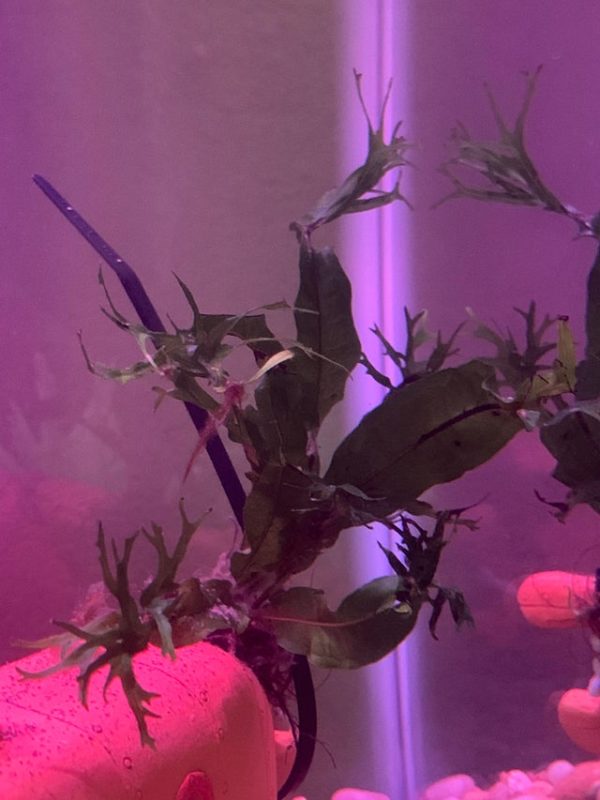
Trident Java Fern – This type is the most uncommon common type. It’s quite beautiful and lives up to its name by having forked leaves. When fully-grown, the Trident will have flowy effect in your tank that many aquarists seem to love.
Needle Leaf – This type of Java Fern is as you would expect, with thinner leaves. It’s quite rare to get your hands on this type of aquatic plant and it’s also quite a small variation. This microsorum pteropus only reaches a maximum of about 6 inches.
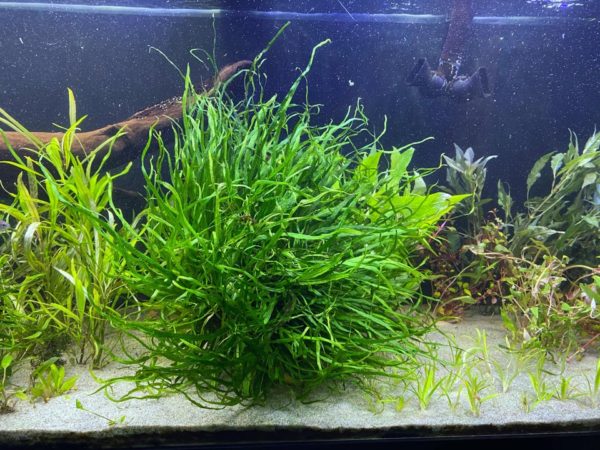
Java Fern Narrow Leaf – The leaves are as the name suggests and has a narrow and long shape. The narrow leaf is a more common breed of the known kinds that can be found quite easily in aquarium stores. They can get up to 12 inches, which means you would need a larger planted aquarium.
Fork Leaf java Fern is an extremely rare variant of Java Fern. The leaf of a mature plant is narrow and replicates the shape of a fork. They are also taller compared to the other varieties. It is a unique addition to your fish tank and is pretty low maintenance.
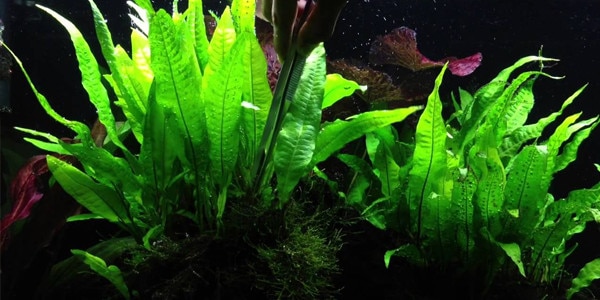
Java Fern Maintenance and Care
How do you care for a Java Fern? Luckily, the Java Fern is a very hardy plant that doesn’t require much from you to start growing. Within several weeks the plant will have made itself a nice home in your planted aquarium. However, to ensure that the microsorum pteropus thrives in captivity, you must first know how to simulate their natural environment to cultivate growth.
In their natural habitat, the Java Fern requires soft acidic water that is relatively fast flowing. They can get enough oxygen from the filters and the natural environment of the aquarium without needing extra CO2 added. The pH should be relatively neutral at 6-7.5 with water hardness at about 3-8 dGH.
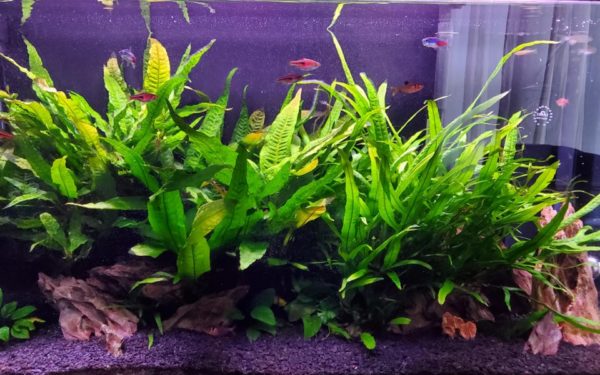
The Java Fern is usually found on the river floors, but it needs rocks and driftwood to hold onto. Bare bottom tanks are a good idea for the Java Fern because they don’t require substrate. They are not a demanding plant species, which is why many people add these hardy plants in their planted aquariums.
For the amount of room your Java Fern needs, just a 10 gallon aquarium will do. Since it could possibly grow to fill out the tank, we don’t recommend going with a tank much smaller than this. They don’t need much lighting, as mentioned before, unless you prefer the darker green shade in your tank.
Growing Java Fern is easy. In general, you can place your Java Fern in places with low light conditions for the best growth. Keeping them away from high light will prevent their leaves from turning brown. The level of light is more difficult to gauge, but you can monitor your Java Fern and once you see signs of browning or transparency, relocate it to a more shaded area. After a few days, your Java Fern should return to normal.
As for the temperature in the tank, the microsorum pteropus likes warmer waters. This is due to them being first discovered in a tropical part of the world. Temperatures are best kept at 68-82 °F (20-28 °C). The Java Fern is a unique plant that can withstand a lot, whether it’s in a planted aquarium or a shared community tank with freshwater fish.
The Java Fern can adapt to many conditions, so chances are when you add a brand new plant, it will make itself right at home. However, don’t be alarmed if it seems like your Java Fern isn’t growing or the leaf structure hasn’t changed. When you plant Java Fern in your tank (not literally plant, but more on that later), it could take a while for it to get used to the environment.
They can also easily be tailored for your own aesthetic preferences. For example, the way you cultivate the plant will affect how it grows. For a bushier appearance, don’t trim or restrict its growth. Just allow your Java Fern to find its way around the tank and let the new plantlets develop.
Remember that the Java Fern takes in nutrients from its leaves, and since their leaves are so far-reaching, it could absorb whatever you have in the tank in abundance. To encourage faster growth, you can add fertilizer to the water. It doesn’t exactly have roots to absorb nutrients the way regular plants do, so please note this when adding supplements.
The hardy Java Fern doesn’t require much pruning and one large overhaul a year should do. Check for brown spots and remove them if any appear. Due to their rootless nature, the Java plant is easy to move around as you clean the tank. You just need to pick up the objects they are attached to and remove them.
How to Plant the Java Fern
Should a Java fern be planted? In short, no, the Java Fern does shouldn’t be planted. As said, the rhizome keeps it firmly in place and all it needs are rocks and driftwood to keep itself anchored. It does not like to be buried and burying the Java Fern can cause it to grow very slowly if at all.
You can sometimes buy the Java Fern straight from the store attached to rocks or driftwood. That is the easiest option since all you would need to do is to place it in your tank. If you bought the Java Fern on its own, then you will need to purchase something similar for it to latch onto.
A rock or driftwood is the best for anchoring thanks to its rough and textured surfaces. Always look for rough surfaces rather than smooth to give the Java Fern an easier time anchoring itself. To help it attach, use fishing wire to secure the rhizome to the object. It doesn’t matter what you use to tie them, fishing wire just looks nice because it blends in with the rhizome.
It only takes a couple of weeks for the Java Fern to plant itself in your tank. After that, you can leave it as is or remove the fishing wire. This step isn’t necessary as it’s only for appearance purposes. The Java Fern will do fine with it remaining tied to the rock or driftwood.
Some people forgo securing the Java Fern altogether and simply place it into the tank. However, the floating rhizomes will continue growing longer and longer until it eventually locates something to secure itself onto. Floating Javas can also be at risk of being eaten by certain aquarium fish.
The Java Fern can grow to be quite lush and overtake your tank. If you don’t want a densely planted tank, you should place this aquarium plant closer to the back. It thrives with other creatures in the tank ranging from freshwater fish to other types of plant life.
Java Fern Uses
What are the benefits of having these plants in your tank? Of course, they make really wonderful decorations for those who want a luscious and more natural-looking environment for their fish. They can be used as a space separator for more territorial fish and the leaves can grow to be large enough to create great hiding spaces. Shrimps and other fully grown, shy, timid faces can find shelter behind large Java Ferns and feel safe. The plant leaves are tough, and they have a foul taste. Therefore, fish tanks of herbivorous fishes like Tetras and some Cichlids are decorated with Java as they will not eat them. It can also help maintain the tank environment by soaking up some of the nitrate levels.
Aquascaping
Looking for a plant to offset the fish in your tank? Start with Javas! You won’t need any fancy equipment in your tanks for it to be a great plant for your fish and their environment.
Knowing the type of leaves the species you purchase possesses will help you find better placement. For example, Windelov Javas grow in a fan-like shape, which will be best suited midtank. Attaching them to driftwood or other objects can secure them and help cultivate them into great little trees.
You can also use the Javas to create walled off areas that will keep aggressive fish away from each other. If you want this jungly look, use some cling film along the back of the habitat. When propagating our ferns, break them up and replant them in such a way to cover up the mesh. We will talk more about how to propagate a bit later. Don’t worry if you aren’t immediately greeted with a lush wall of greenery as the plants will fill out the holes later on.
How to Buy a Java Fern
Not knowing how to buy a healthy plant is a common problem. When at the store, how do you know which plant to choose? In general, we would recommend choosing a plant that is already 3-5 inches high (depending on the species you want). The first thing you want to do is to take a closer look at the plant itself. Does it have any unhealthy markings such as browning? Remember that brown spots are not necessarily a sign of an unhealthy plant, especially if they are present on the leaves.
Look for coloring that is vivid and bright on these plants. Start by checking the leaves, then the rhizome, then the roots. The leaves should be bright or dark green and the rhizome a dark green. The roots are a brown to black color and are long and thin like hair.
It will also help to identify the different types without just recognizing them by name. The regular and most common Java has thin, long and wavy leaves. You may be able to find these aquatic plants in most stores. The Windelov have thinner leaves than the regular type. The narrow and trident we have already introduced in the above section. We then have two more species that are great additions, the small Java and the Latifolia.
The small Javas are just a smaller version of the regular, which are great in smaller tanks. Even if you have a larger one, they can create a multi-dimensional effect when put together with the bigger versions. For those that want ones they won’t outgrow their tanks, the smaller version is also a good choice for that reason.
The Latifolia is a beautiful variety of the plant that has larger and broader leaves.
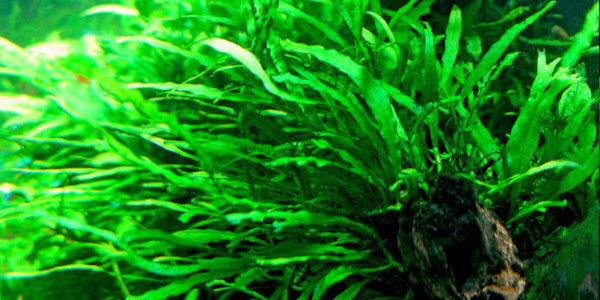
Common Care Issues
Whether you have a new tank, new fish, or an already established community, when integrating new plant life or fish you should always provide them with the right conditions to flourish. As we mentioned before, the Java Fern is unique in the sense that it does not have roots and shouldn’t be planted. It’s a tough plant and can survive if buried under substrate for a while, but it will lead to its death eventually.
Don’t be alarmed if your Java Fern is a slow grower in the beginning. These plants like to attach themselves to objects, and that can take them a few weeks to do. During this time, your Java plant is just getting accustomed to its surroundings. However, if it’s been a few weeks and you are still not experiencing any growth, you can start by adding a little bit of fertilizer to the tank to speed up the process.
In general, once the Java plant is attached to its chosen object, you will start noticing subtle growth. Another piece of important information to keep in mind is not to equate the brown spots with an unhealthy aquarium plant. The brown or black circles are actually where new leaves will sprout from.
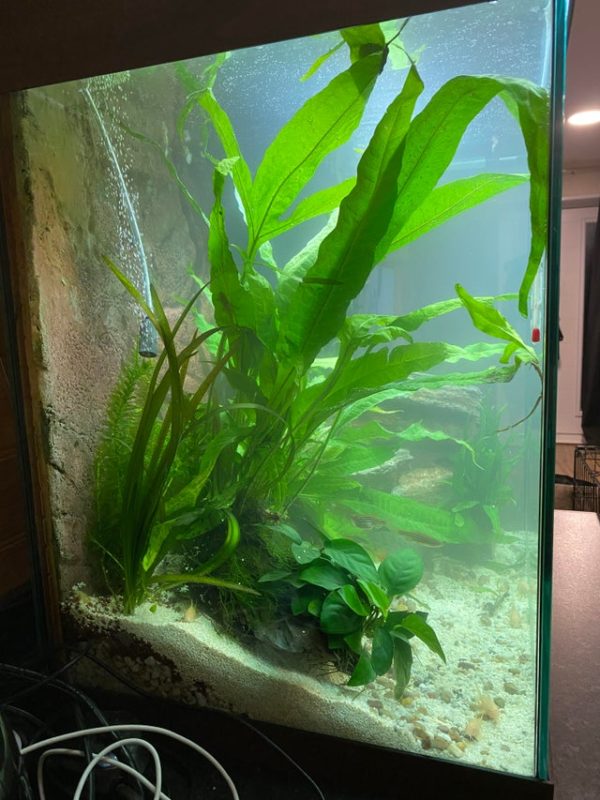
If you notice that the spots do not yield young plantlets or are of a different color, that is when you should make some adjustments. Other spots could be burn spots, which can heal once you remove the plant from the light and into a shaded area.
Plant melt is something most types of plants in the tank can encounter. It is exactly what it sounds like as a part of your plant appears to melt away into a mushy heap. This really only happens in tanks with too much blue-green algae or if your plant is nutrient deficient. Java plants don’t go together with algae so keeping cleaner fish in the tank can be a great solution to the problem. Too much lighting can also cause this melting. Simply turn off the lights for three days and cover the aquarium with a thick blanket. This will give enough time to the plants to repair themselves.
One surefire way to prevent any of the above issues is to take good care of your microsorum plants is to give them the best environment. Regular cycling of the tank and proper water parameters will guarantee beautiful plants.
Java Fern Propagation and Cultivation
Like fish, plants can be “bred” too. The difference is we call the breeding of plants propagation. The Java Fern is as easy to propagate as it is to keep, and requires little effort. They propagate themselves by cloning and not by seed production. As long as you do your part, the process will most likely be successful.
You can start by cutting the rhizome and planting the separate sections. It’s as easy as that. Cutting off parts of the original plant and replanting them around the tanks. Give them time to seek out rocks, driftwood, or other surfaces to latch onto. Once attached, the baby Java Ferns will start to grow. To hurry up the process, you can also tie the growing Java Ferns to the objects as suggested above. This is just one way for propagation.
Another effective and easy method is to wait for the Java Fern to create tiny Java Ferns. These are the little plantlets we talked about above that develop from the black or brown circles. It does take a while to see the little plantlets, so if you are impatient, we suggest going with the first solution.
Cultivation of Java Ferns is easier on rough surfaces than smooth ones. Extremely smooth surfaces will take too long to attach to the object. Tie the plant’s roots with nylon fishing wires and avoid adding harsh chemicals into the water.
Within a few weeks, the roots will hook themselves into the object’s surface. Once the roots are secure, you can untie them without touching the wires. As the tree grows, it will cover the wires completely.
How to Trim Javas
Even though we mentioned that the Javas don’t require a whole lot of maintenance including pruning, it still needs to be done. One problem is randomly cutting the leaves, which we want to discourage people from doing. Do not just do away with all the larger leaves. Just snip off several pieces and you will notice new plantlets growing quickly after.
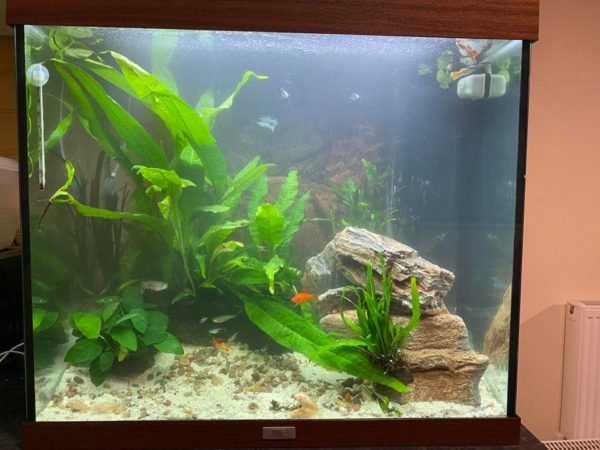
If you do experience Java melt of dead leaves, you will need to remove it all, but not at once. Before starting to trim, you should start by checking the entire plant first, from leaves to rhizome. This will ensure you will be very thorough with the pruning job. If all the dead leaves are not removed, it could spread to the healthy leaves and eventually the rhizome.
Again, we stress that you should not trim all the dead leaves at once as this could shock the plant. Locate the diseased and damaged leaves and remove just a few every time. Leave enough time to pass between prunes, we would say a week or so.
When you notice several new plantlets, they are safe to remove as well. Instead of trimming rhizomes to propagate new plants, you can use the plantlets.
Java Fern Compatibility
Even before you add the Java Fern to your tank, you need to know its compatibility with other species. Whether you intend to keep fish in the tank or other plants, you need to make sure it will grow healthily in its new home. Luckily, the Java Fern is a popular plant to add because it goes well is a variety of fish. Most fish will steer clear of the Java Fern and won’t tend to nip at its leaves.
Large or small fish, aggressive or not, various marine species will get along with this plant. Since it’s naturally tough, the Java Fern can get used to various water conditions as long as it’s not too cold and the pH remains relatively neutral. Due to this, you can cater to the fish first and not worry so much about growing your plant.
A few great species of fish to live in harmony with the Java Fern include: cichlids, catfish, arowanas and angelfish. You would need to pay more attention to the fish and plants in the beginning when the Java Fern hasn’t put down roots yet or properly attached itself. A floating plant may be easily knocked around, so to avoid any damage to the plant, we recommend attaching it than leaving it floating.
Conclusion
The Java Fern is an amazing beginner plant that will do well in most tanks. They are very easy to keep and get along well with may species of fish and other plants. One thing to keep in mind is their potentially slow growing nature and the need to be anchored. They are a hardy and robust species of plant. If you want a jungly look or just some vegetation for decoration, you may find the Java Fern to be one of the best choices.
They also come in different varients and their leaves can differ in shape and size. Some are easier to find than others but one thing is for sure, these plants will make for a very good investment and an even better decoration for the tank.
